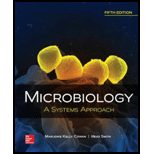
Microbiology: A Systems Approach
5th Edition
ISBN: 9781259706615
Author: Marjorie Kelly Cowan Professor
Publisher: McGraw-Hill Education
expand_more
expand_more
format_list_bulleted
Concept explainers
Question
Chapter 21.5, Problem 19AYP
Summary Introduction
To explain:
The chain of transmission of the causative agent of Hantavirus pulmonary syndrome.
Concept introduction:
Hantavirus pulmonary syndrome is caused by Hantavirus. It causes kidney disease and hemorrhagic fevers. It also causes fever, headache, nausea, and vomiting in patients. The deer mouse (Peromyscus maniculatus) is the rodent known to carry this virus.
Expert Solution & Answer
Want to see the full answer?
Check out a sample textbook solution
Students have asked these similar questions
Describe two different gene regulation mechanisms involving methylation
What is behavioral adapt
22. Which of the following mutant proteins is expected to have a dominant negative effect when over-
expressed in normal cells?
a. mutant PI3-kinase that lacks the SH2 domain but retains the kinase function
b. mutant Grb2 protein that cannot bind to RTK
c. mutant RTK that lacks the extracellular domain
d. mutant PDK that has the PH domain but lost the kinase function
e. all of the above
Chapter 21 Solutions
Microbiology: A Systems Approach
Ch. 21.1 - Prob. 1AYPCh. 21.1 - Prob. 2AYPCh. 21.2 - Prob. 3AYPCh. 21.3 - Prob. 4AYPCh. 21.3 - Prob. 5AYPCh. 21.3 - Prob. 6AYPCh. 21.4 - Prob. 7AYPCh. 21.4 - Prob. 8AYPCh. 21.4 - Prob. 9AYPCh. 21.4 - Prob. 10AYP
Ch. 21.4 - Plan a response for a situation in which a patient...Ch. 21.4 - Compare and contrast antigenic drift and antigenic...Ch. 21.5 - Prob. 13AYPCh. 21.5 - Prob. 14AYPCh. 21.5 - Prob. 15AYPCh. 21.5 - Prob. 16AYPCh. 21.5 - Prob. 17AYPCh. 21.5 - Prob. 18AYPCh. 21.5 - Prob. 19AYPCh. 21 - Prob. 1MCQCh. 21 - Prob. 2MCQCh. 21 - Which is not a characteristic of Streptococcus...Ch. 21 - The common stain used to identify Mycobacterium...Ch. 21 - Prob. 5MCQCh. 21 - Prob. 6MCQCh. 21 - Which of the following infections often has a...Ch. 21 - Prob. 8MCQCh. 21 - Prob. 9MCQCh. 21 - Prob. 10MCQCh. 21 - Prob. 11TFCh. 21 - Prob. 12TFCh. 21 - Prob. 13TFCh. 21 - Prob. 14TFCh. 21 - Prob. 15TFCh. 21 - Prob. 1CTQCh. 21 - Prob. 2CTQCh. 21 - Prob. 3CTQCh. 21 - In an episode of the television show House. Dr....Ch. 21 - Prob. 5CTQCh. 21 - Prob. 1VCCh. 21 - Prob. 1CM
Knowledge Booster
Learn more about
Need a deep-dive on the concept behind this application? Look no further. Learn more about this topic, biology and related others by exploring similar questions and additional content below.Similar questions
- Explain how the hormones of the glands listed below travel around the body to target organs and tissues : Pituitary gland Hypothalamus Thyroid Parathyroid Adrenal Pineal Pancreas(islets of langerhans) Gonads (testes and ovaries) Placentaarrow_forwardWhat are the functions of the hormones produced in the glands listed below: Pituitary gland Hypothalamus Thyroid Parathyroid Adrenal Pineal Pancreas(islets of langerhans) Gonads (testes and ovaries) Placentaarrow_forwardDescribe the hormones produced in the glands listed below: Pituitary gland Hypothalamus Thyroid Parathyroid Adrenal Pineal Pancreas(islets of langerhans) Gonads (testes and ovaries) Placentaarrow_forward
- Please help me calculate drug dosage from the following information: Patient weight: 35 pounds, so 15.9 kilograms (got this by dividing 35 pounds by 2.2 kilograms) Drug dose: 0.05mg/kg Drug concentration: 2mg/mLarrow_forwardA 25-year-old woman presents to the emergency department with a 2-day history of fever, chills, severe headache, and confusion. She recently returned from a trip to sub-Saharan Africa, where she did not take malaria prophylaxis. On examination, she is febrile (39.8°C/103.6°F) and hypotensive. Laboratory studies reveal hemoglobin of 8.0 g/dL, platelet count of 50,000/μL, and evidence of hemoglobinuria. A peripheral blood smear shows ring forms and banana-shaped gametocytes. Which of the following Plasmodium species is most likely responsible for her severe symptoms? A. Plasmodium vivax B. Plasmodium ovale C. Plasmodium malariae D. Plasmodium falciparumarrow_forwardStandard Concentration (caffeine) mg/L Absorbance Reading 10 0.322 20 0.697 40 1.535 60 2.520 80 3.100arrow_forward
arrow_back_ios
SEE MORE QUESTIONS
arrow_forward_ios
Recommended textbooks for you
 Medical Terminology for Health Professions, Spira...Health & NutritionISBN:9781305634350Author:Ann Ehrlich, Carol L. Schroeder, Laura Ehrlich, Katrina A. SchroederPublisher:Cengage Learning
Medical Terminology for Health Professions, Spira...Health & NutritionISBN:9781305634350Author:Ann Ehrlich, Carol L. Schroeder, Laura Ehrlich, Katrina A. SchroederPublisher:Cengage Learning- Essentials of Pharmacology for Health ProfessionsNursingISBN:9781305441620Author:WOODROWPublisher:CengageHealth Safety And Nutrition F/Young ChildHealth & NutritionISBN:9781305144767Author:MAROTZPublisher:CengageCase Studies In Health Information ManagementBiologyISBN:9781337676908Author:SCHNERINGPublisher:Cengage


Medical Terminology for Health Professions, Spira...
Health & Nutrition
ISBN:9781305634350
Author:Ann Ehrlich, Carol L. Schroeder, Laura Ehrlich, Katrina A. Schroeder
Publisher:Cengage Learning


Essentials of Pharmacology for Health Professions
Nursing
ISBN:9781305441620
Author:WOODROW
Publisher:Cengage

Health Safety And Nutrition F/Young Child
Health & Nutrition
ISBN:9781305144767
Author:MAROTZ
Publisher:Cengage

Case Studies In Health Information Management
Biology
ISBN:9781337676908
Author:SCHNERING
Publisher:Cengage